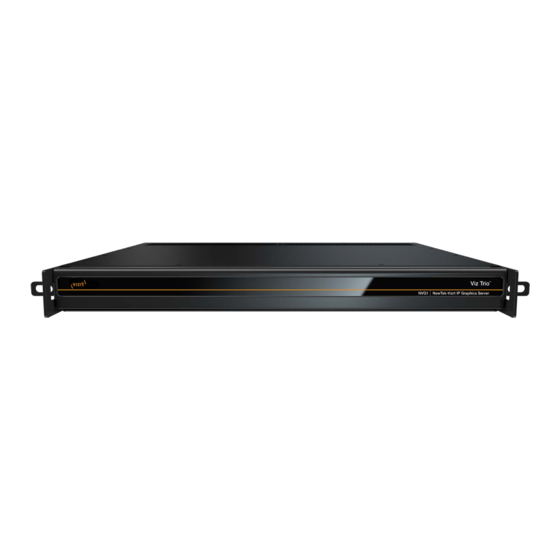
Table of Contents
Advertisement
Quick Links
Advertisement
Table of Contents

Summary of Contents for NDI NewTek NVG1
- Page 1 NVG1 NewTek-Vizrt IP Graphics Server Quick Start Guide...
- Page 2 Revised –May 1, 2017 Trademarks: NewTek, NewTek VMC1, NewTek VMC1 IN, NewTek VMC1 OUT, NewTek NC1, NewTek NC1 IN, NewTek NVG1, TriCaster, TriCaster TC1, TriCaster Advanced Edition, TriCaster XD, TriCaster 8000, TriCaster TCXD8000, TCXD8000, TriCaster 860, TriCaster TCXD860, TCXD860, TriCaster 460, TriCaster TCXD460, TCXD460, TriCaster 410, TriCaster TCXD410, TCXD410, TriCaster Mini SDI,...
-
Page 3: Table Of Contents
2.1.5 Checking the Output..............................13 2.1.6 Checking Control Commands ............................13 Section 2.2 Full Vizrt Documentation Links ..........................14 APPENDIX A: NDI (NETWORK DEVICE INTERFACE) ................15 APPENDIX B: DIMENSIONS AND MOUNTING ..................15 APPENDIX C: SOFTWARE SUPPORT & RENEWAL .................. 16 APPENDIX D: ENHANCED SUPPORT (PROTEK) .................. -
Page 4: Introduction And Setup
1RU server with Vizrt’s industry-leading Viz Trio™ character generator and Viz Engine™ compositing software. Built with IP workflows in mind, the NVG1 provides deep integration and connectivity with NewTek’s IP Series and TriCaster line of live production systems via NewTek’s NDI (Network Device ®... -
Page 5: Section 1.3 Setting Up
Change colors, textures, and looks on-the-fly Transition Logic • Supports HD & 4K UHD • Macro automation control • Support for the full line of Vizrt workflow products • Generic news & sports graphics package included • Availability of custom graphics packages •... -
Page 6: Section 1.5 Networking
3. USB – connect keyboard, mouse and other peripheral devices. 4. Motherboard audio connectors 5. GPU display port connectors 6. Power NETWORKING SECTION 1.5 Generally, simply connecting a suitable cable from one of the two Gigabit Ethernet ports on NVG1’s backplate is all that is required to add it to a local area network (LAN). -
Page 7: License Expiration
3. The Viz Config window will open 4. Select Viz License Information 5. Confirm the Sys ID on the window matches the Hardlock Dongle ID in the email 6. Copy the License from the License Information File 7. Paste the License into the License field and press Enter 8. -
Page 8: Getting Started
GETTING STARTED This chapter explains how to start the Vizrt software, load a project, and get an output on screen. After this section, the NVG1 is fully operational and ready to use either the installed generic graphics packages or other Vizrt projects from other sources, including custom graphics packages. - Page 9 5. Select the Output Format section, and pick your desired resolution 6. Repeat the process for Viz Engine 1, and Viz Engine 2...
- Page 10 7. Double-click on the Viz Trio icon on the desktop, Trio will automatically start the preview channel 8. After Viz Trio launches return to the desktop and double click on Viz Engine 1 and Viz Engine 2 desktop icons. 9. The Viz Engine console windows will pop up, but they can be minimized Page | 10...
-
Page 11: Loading A Vizrt Project
CONNECTING TO A NEWTEK LIVE PRODUCTION SYSTEM 2.1.3 1. Once the NVG1 system and Viz Engine/Trio software are up and running, the graphics channels should appear on the network as NDI sources ® 2. To see the Viz Engine outputs on a TriCaster or IP Series, you need to assign them to switcher inputs... - Page 12 4. Float your cursor over the gear icon and select it 5. On the Input Settings tab, click on the Source drop-down menu to view all the NDI sources on the network 6. Select the NDI source for Trio Preview, Viz Engine 1, or Viz Engine 2 (they will be labeled with the machine name of the NVG1 followed by -0, -1, and -2, if you have a dual channel system) 7.
-
Page 13: Checking The Output
Before sending commands, it is required to make certain the channel names are configured correctly. The Viz Trio channels must match the channel name of the NDI input. You can verify the names by looking in the bottom left corner of the Trio Interface. -
Page 14: Section 2.2 Full Vizrt Documentation Links
TriCaster or VMC1. Conceptually the commands flow from TriCaster or VMC1 via NDI to the Viz Engine generating the NDI source. The Viz Engine then forwards the command to Viz Trio, which in turn directs the Viz Engine accordingly. -
Page 15: Appendix A: Ndi (Network Device Interface)
NewTek’s live video production systems and a growing number of third party systems provide direct support for NDI, both for ingest and output. Although NVG1 provides many other useful features, it is purpose designed primarily to turn SDI sources into NDI signals. -
Page 16: Appendix C: Software Support & Renewal
The units weigh nearly 14 pounds (6.35 KG). A shelf or rear support will distribute the load more evenly if rack-mounted. Good front and rear access is important for convenience in cabling should be considered. In view of the top panel vents on the chassis, at least one RU should be allowed above these systems for ventilation and cooling. -
Page 17: Credits
Additional thanks to: NewTek Marketing, Sales, Business Development, Customer Support, Training and Development, and Operations Trademarks: NewTek, NewTek VMC1, NewTek VMC1 IN, NewTek VMC1 OUT, NewTek NC1, NewTek NC1 IN, NewTek NVG1, TriCaster, TriCaster TC1, TriCaster Advanced Edition, TriCaster XD, TriCaster 8000, TriCaster TCXD8000, TCXD8000, TriCaster 860, TriCaster TCXD860, TCXD860, TriCaster 460, TriCaster... - Page 19 . NX-001929-0001 Rev.05 Copyright © 1990-2017 NewTek Inc. San Antonio TX USA...
Need help?
Do you have a question about the NewTek NVG1 and is the answer not in the manual?
Questions and answers